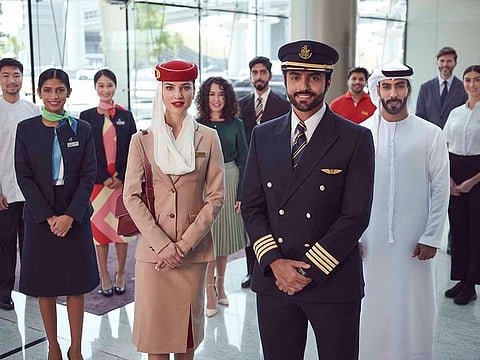Aviation Future Week: Emirates plans 40-50% workforce expansion over next decade
Emirates plans to increase numbers of cabin crew, engineers, and pilots as airline grows

Dubai: Dubai’s flagship carrier, Emirates, plans to boost the number of cabin crew, engineers, and pilots working at the airline, targeting a 40-50 per cent workforce growth over the next decade as it continues on its growth journey.
“We will continue to expand our workforce, increasing the number of cabin crew, engineers, and pilots. We anticipate a significant increase in manpower, targeting a growth of 40-50 per cent over the next ten years,” Adel Ahmad Al Redha, Deputy President and Chief Operations Officer of Emirates Airline, told Gulf News on the sidelines of the first edition of Aviation Future Week on Tuesday.
Emirates Group’s total workforce grew by 10 per cent to 112,406 employees, the airline said in its 2023-24 annual report, released in May this year.
Recently, the airline also invested a staggering $48 million in pilot and cabin crew training in preparation for the arrival of its much-anticipated Airbus A350 aircraft.
Geopolitical impact
Emirates and other regional carriers have faced significant challenges this year amid growing geopolitical tensions. These tensions have led to aircraft diversions and closed airspaces, which have impacted revenue and operating expenses.
Al Redha explained that while the airline has faced challenges this year, the impact on its bottom lines “hasn’t been significant so far”, and Emirates’ growth trajectory is poised to demonstrate an upward swing despite these challenges.
“We've faced challenges this year, including heavy rains (in April) that led to numerous aircraft diversions, sudden airspace closures, and the inability to operate to certain destinations due to ongoing conflicts,” Al Redha said.
Airline President Sir Tim Clark said in an earlier media briefing that the rains cost the airline $110 million.
“These factors have affected our total revenue and, in some areas, our operating expenses. So far it hasn't been significant, but, if it continues in this nature, it is going to come to an amount that we can't ignore,” Al Redha said.
As for this financial year, Al Redha said it is still too early to assess the full extent of the impact on airline revenues, as the fiscal period has yet to conclude. “There are still six months to go (Emirates’ financial year is from April 1 to March 31), and the situation remains fluid. However, the first six months of operations have been strong, with robust revenue and a healthy number of passenger and cargo operations,” he explained. Moreover, Al Redha said the airline has performed well this summer, and the outlook for December and future bookings is also quite positive.
777X delivery delays
On Monday, airline President Clark said it plans to hold a ‘serious conversation' with US plane maker Boeing after it pushed back the delivery date for its 777X, delaying its largest wide-body aircraft by about six years. Boeing has attributed the delays to a pause in the flight test and strikes by Union workers. The plane, however, is crucial to Emirates' future wide-body fleet.
Emirates, already the world’s largest operator of Boeing 777 aircraft, signed firm orders for 55 additional 777-9s and 35 777-8s during the Dubai Airshow last year. This takes the airline’s 777-X order book to a total of 205 units. From its previous order of 115 units, the first 777-9 were expected to join Emirates’ fleet in 2025.
As a mitigation measure, Emirates launched a mammoth retrofit programme for its Airbus A380 and Boeing 777 fleet. The project, done entirely in-house to extend the lifespan of its existing fleet, was forced to increase its budget from $2 billion to $4 billion.
Al Redha said, “The situation is such that we are not currently able to establish a definitive delivery timeline. We will have further discussions (with Boeing) to understand better their plans for restoring the certification program and the timeline for the delivery and production of the aircraft,” he stated.
Emirates has retrofitted 31 of the older aircraft in the airline’s fleet, including six Boeing 777s and 19 Airbus A380s. All retrofit projects took place in-house at the Emirates Engineering Centre. “We’re making changes to the Emirates Engineering Center plans. The strategy is to do more in-house, expanding our capabilities and facilities. The plan includes 24 hangar bays at DWC to meet future maintenance needs and support retrofit programmes,” he said.
A350 deliveries, deployment
On the other hand, Emirates is anticipating the delivery of its first Airbus A350 in November this year. "We are planning to deliver the first aircraft in the first week of November. And over the next three and a half years, we anticipate taking delivery of 65 aircraft. Once we take delivery of the first aircraft, subsequent deliveries should continue on schedule,” said Al Redha.
Commenting on deployment plans for the A350, Al Redha said, “We have two configurations for the A350: one with a three-class layout and another without first class. The aircraft without first class will be deployed on routes under 10 hours, including some destinations in Europe, India, the Far East, and even the Middle East.”
However, once all 65 aircraft join the airline, Al Redha said they will be able to increase frequencies to certain destinations, add new ones, and replace larger aircraft on some routes.
Sign up for the Daily Briefing
Get the latest news and updates straight to your inbox



